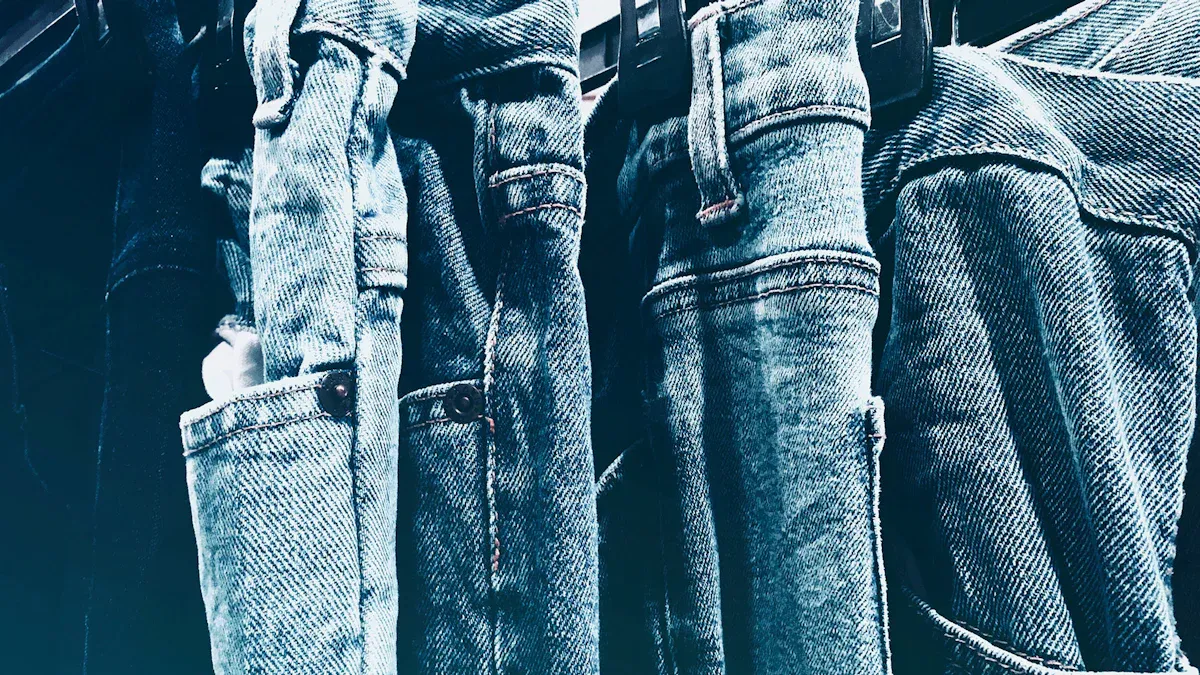
Every pair of jeans tells a story, and the secret lies in the wash. When you pick up denim, you hold a piece of fabric shaped by water, stones, or even lasers. Popular washes like dark indigo and vintage washed jeans give you choices for every occasion. Across the globe, people prefer different denim washes depending on their style and culture.
Region | Key Consumer Preferences | Trends in Denim Washes |
|---|---|---|
Europe | Focus on fashion, quality, and sustainability. High demand for premium and designer denim. | Emphasis on raw or selvedge denim, influenced by urban fashion trends. |
Asia Pacific | Rising disposable incomes and a fashion-conscious youth demographic. | High demand for trendy and affordable denim influenced by K fashion and J fashion trends. |
Latin America | Diverse fashion preferences with a growing appetite for branded apparel. | Increasing awareness of sustainable and ethically produced clothing. |
Middle East & Africa | Evolving consumer tastes with a blend of global and local styles. | Demand for modest cuts in Gulf countries versus ripped jeans in South Africa. |
You see how the journey of denim begins with the wash, setting the stage for style, comfort, and personality.
Key Takeaways
Denim washes transform raw fabric into stylish jeans. Each wash creates a unique look and feel.
Rinse wash is a great starting point for comfort and style. It softens denim while keeping its classic color.
Eco-friendly washes, like enzyme wash, are better for the environment. They use fewer chemicals and help protect water systems.
Distressed and innovative washes add character to jeans. They reflect personal style and current fashion trends.
Understanding denim washes helps you choose jeans that fit your style and last longer.
Different denim washes: The journey begins

Every story has a beginning, and for denim, it starts with the first wash. You see denim as a blank canvas, waiting for transformation. The journey from raw denim to washed denim sets the stage for all the different denim washes you find in stores today. These first steps decide the texture, color, and character of your jeans.
Raw denim
Raw denim stands as the purest form of denim. You get fabric straight from the loom, untouched by water or chemicals. The deep indigo color looks bold and rich. When you wear raw denim, you shape its story. The fabric feels stiff at first, but it softens over time. You notice creases and fades that match your movements. Raw denim develops a unique look with every wear, making each pair personal.
You might wonder how raw denim becomes the foundation for different types of denim washes. The process starts with simple steps, but each one changes the fabric’s personality. Here is a table that shows how raw denim transforms into washed denim through various processes:
Step | Process Type | Description |
|---|---|---|
1 | Enzyme Wash | Uses enzymes to fade color and soften fabric. |
2 | Bleach Wash | Applies bleach for further lightening of the denim. |
3 | Hydroextraction | Removes excess water to prepare for subsequent steps. |
4 | Acid Wash | Creates a marbled effect using a thermosall ball spraying method. |
5 | Neutralization | Stops bleaching action and removes residual chemicals. |
6 | Clean Up | Involves pH neutralization and enhancing blue tones. |
7 | Final Hydroextraction | Prepares denim for drying by removing remaining water. |
8 | Final Dry Process | Additional hand-sanding or laser touch-ups for enhanced effects. |
Raw denim gives you the chance to create natural whiskering and fading. You see how hand sanding and scraping add vintage vibes. Laser finishes provide precise patterns and use less water, making them more sustainable. When you choose raw denim, you start with a blank slate and watch it change with every wash and wear.
Rinse wash
Rinse wash marks the first chapter in the transformation of denim. You get denim that has been washed once in water to remove excess dye and starch. The result feels softer than raw denim but keeps much of its original color. Rinse wash creates a clean, dark look that works well for both casual and dressy outfits.
You notice that rinse wash sets the foundation for all other washes. It prepares the denim for further treatments, such as enzyme or bleach washes. Rinse wash also helps prevent color transfer, so your jeans do not stain other clothes. The fabric feels comfortable from the start, making it easy to wear right away.
Tip: If you want jeans that look sharp and last long, start with rinse washed denim. You get the classic indigo shade with a touch of softness.
Both raw denim and rinse wash serve as the building blocks for different denim washes. You see how each step in the process adds character and style. The journey begins here, and every wash that follows brings new life to your jeans.
Classic fades and textures
You step into the world of classic denim washes and discover how each technique shapes the look and feel of your jeans. These washes create the faded blues, textured surfaces, and vintage vibes that define washed denim. You see how designers use different types of denim washes to build seasonal collections and offer new styles every year.
Stone wash
Stone wash denim gives you that iconic worn-in look. You find jeans with a soft texture and faded color. Factories tumble denim with pumice stones, which roughen the surface and lighten the indigo shade. You notice that stone wash denim feels comfortable from the first wear. The wash creates random patterns, so every pair looks unique.
You should know that stone wash denim has environmental impacts. Classic denim wash techniques like stone wash and acid wash generate excessive waste. The U.S. Environmental Protection Agency reported that in 2018, 11.3 million tons of textiles ended up in landfills. These methods also weaken the fabric, which shortens the lifespan of your jeans and increases waste. You can help reduce these impacts by choosing brands that use eco-friendly laundry systems. These systems protect the quality of denim and help preserve the environment.
Acid wash
Acid wash denim stands out with its bold, marbled patterns. You see jeans with dramatic contrasts between dark and light areas. Factories create acid wash by soaking denim in chemicals and tumbling it with stones. This process strips color from the surface, leaving behind striking white streaks and patches.
You find acid wash denim in many fashion collections. Designers love to use acid wash denim for its edgy style and retro appeal. You notice that acid wash denim works well for jackets, jeans, and skirts. The wash gives you a rebellious look that fits streetwear and vintage trends.
You should pay attention to health and safety when working with acid wash denim. Workers must follow strict guidelines to stay safe during the wash process.
Safety Consideration | Description |
|---|---|
Follow MSDS | Always adhere to the Material Safety Data Sheet for each chemical used. |
Neutralization | Ensure neutralization after bleaching to prevent fabric damage. |
Chemical Use | Avoid excessive use of permanganate or chlorine-based agents. |
Personal Protective Equipment | Workers must wear goggles, gloves, and masks. |
You see that acid wash denim requires careful handling to protect both workers and the fabric.
Snow wash
Snow wash creates a frosty, speckled effect on denim. You see jeans with scattered white spots that look like fresh snow. Factories achieve this look by using stones soaked in bleach. The stones rub against the denim, removing color in small patches. You get a playful, textured style that stands out in any crowd.
You notice that snow wash works best on light denim. The wash highlights the natural texture of the fabric and adds depth to your jeans. You find snow wash in casual collections and vintage-inspired designs. The technique gives you a fun way to express your personality through different denim washes.
Fade wash
Fade wash brings out the natural aging process of denim. You see jeans with gradual transitions from dark to light. Factories use gentle abrasion and controlled washing to mimic years of wear. You get a soft, broken-in feel and a classic faded look.
Designers use fade wash to create timeless pieces for every season. You find faded jeans in both men’s and women’s collections. The wash works well with other finishes, such as whiskering or distressing. You can pair faded denim with almost anything in your wardrobe.
“We started off with the classic blue wash to test how that goes. That’s the most versatile, I think. And then we’ll start seeing if we can introduce a few different colorways and styles as well.”
You see how fashion designers experiment with different denim washes to offer new looks and textures. You can choose washed denim with classic fades or bold patterns to match your style.
You learn that classic washes like stone wash denim and acid wash denim shape the story of your jeans. You discover how each wash creates unique textures and colors. You understand the environmental and safety challenges linked to these techniques. You see how designers use different types of denim washes to inspire new trends and collections.
Vintage and character washes
You step into the world of vintage and character washes, where denim tells stories of music, culture, and personal style. In the 1980s, acid washing exploded in popularity. Bands like Poison wore heavily bleached and ripped jeans, making washed denim a symbol of rebellion and glam metal. You see how different denim washes reflect cultural movements and personal expression.
Enzyme wash
Enzyme wash uses natural enzymes to break down fibers in denim. You get a smooth, clean finish that feels soft against your skin. Factories use cellulase enzyme to remove indigo and create a gentle fade. This process is eco-friendly because enzymes are biodegradable. You notice that enzyme wash gives you washed denim with a modern touch, perfect for everyday wear.
Here is a table that compares enzyme wash and bleach wash:
Wash Type | Process Description | Effect | Environmental Impact |
|---|---|---|---|
Bleach Wash | Treated with sodium hypochlorite or hydrogen peroxide | Faded, cloudy, light-blue tone | High – can harm water systems if not neutralized |
Enzyme Wash | Uses cellulase enzyme to remove indigo and soften fabric | Smooth, clean finish | Low – biodegradable and eco-friendly |
You see that enzyme wash offers a sustainable choice compared to traditional methods.
Bleach wash
Bleach wash creates a faded, cloudy look on denim. Factories treat denim with chemicals like sodium hypochlorite or hydrogen peroxide. You get jeans with a light blue tone and a soft texture. Bleach wash can harm water systems if not neutralized, so you should look for brands that use safe practices. You notice that bleach wash works well for ocean wash denim and salt wash denim, giving you a fresh, beach-inspired style.
Tip: Choose bleach washed denim for a light, airy look that pairs well with summer outfits.
Whiskering
Whiskering adds faded crease lines around the thigh and hip. You see these lines on vintage jeans, giving them a natural worn look. Factories use sandpaper or laser to create whiskering. Laser is the most eco-friendly method. You notice whiskering on ocean wash denim and salt wash denim, adding character and depth.
Process | Effect | Impact |
|---|---|---|
Creates faded crease lines around the thigh and hip using sandpaper or laser. | Natural worn look. | Low — laser is the most eco-friendly method. |
You see how whiskering, along with different types of denim washes, shapes the personality of your jeans.
Cultural influences play a big role in the popularity of different denim washes. You notice how Levi’s “Live in Levi’s” campaign with BTS boosted youth appeal and sales in Korea. Billie Eilish’s self-expression in Calvin Klein’s campaign inspired millions. K-pop idols like Jennie Kim blend streetwear and minimalism, turning ocean wash denim and salt wash denim into lifestyle statements.
You discover that vintage and character washes give denim a unique story. You can choose washed denim with enzyme, bleach, or whiskering effects to match your style and values.
Distressed and modern finishes

You enter the world of distressed denim, where every pair tells a story of adventure and individuality. Modern washes give you options that go beyond classic looks. You see how sandblasted, distressed, and innovative finishes create unique textures and effects. These techniques shape seasonal denim styles and reflect your personality.
Sandblasted wash
Sandblasted denim stands out with its rugged surface and faded highlights. Factories use high-pressure sand to wear down the fabric, creating a medium to dark wash denim with dramatic contrasts. You notice how sandblasted jeans often feature light wash denim patches and medium tones, giving you a bold, worn-in look. This process works well for both medium and dark denim, adding depth and character. You find sandblasted finishes in seasonal denim styles, especially those inspired by outdoor adventures.
Distressed wash
Distressed denim takes the story further. You see jeans with frayed edges, holes, and whiskering. Factories use sandblasting, scraping, and hand-tearing to create a rugged, worn appearance. Distressed washes give you a choice between medium wash denim and dark wash denim, each with its own vibe. You can pick light wash denim for a casual look or dark for a more dramatic effect. The table below shows the main style differences between distressed washes and specialty finishes:
Technique | Process Description | Effect | Impact Level |
|---|---|---|---|
Distressed Washes | Involves sandblasting and whiskering to create a rugged, worn appearance. | Rugged, worn look | Very high |
Specialty Finishes | Techniques like acid wash and enzyme wash focus on achieving specific aesthetics. | Specific aesthetic effects | Varies |
Distressed denim remains popular in seasonal denim styles. You see it in streetwear, music festivals, and everyday outfits.
Innovative washes (ozone, laser, specialty)
You discover how technology transforms denim. Innovative washes use ozone, laser, and specialty methods to create washed denim with less environmental impact. Laser fading replaces traditional stone washing, reducing water use and eliminating pumice waste. Ozone and e-flow technologies cut chemical usage by up to 60%. Waterless dyeing and recycled cotton yarns change how denim is made. You see brands using advanced enzymatic solutions, improved finishing agents, and smart application systems to create medium and dark wash denim with new properties.
Note: You can look for denim with certifications like GOTS, OEKO-TEX, BCI, and bluesign to ensure eco-friendly washes.
You notice a shift in consumer attitudes. People now demand sustainable practices and materials in denim production. You see more transparency in supply chains and a focus on eco-friendly materials, especially among younger buyers. Modern washes let you choose denim that matches your values and style.
You now see how every denim wash tells a different story. When you understand the types of washes, you can choose jeans that match your style and comfort needs.
Each technique creates a look and feel that fits your personality.
Knowing about denim helps you pick jeans that last longer and require less care.
Type of Denim | Recommended Care Method |
|---|---|
Raw Denim | Hand wash gently, avoid machines, minimal washing to develop unique fades. |
Selvedge Denim | Cold, gentle washes, careful drying to maintain durability and signature edges. |
Stretch Denim | Wash cold to avoid heat damage, hang dry to keep elasticity. |
Pre-washed/Distressed | Mild washing and air drying to maintain texture, less sensitive than other types. |
You can shop with confidence and find denim that fits your life.
FAQ
What is the difference between raw denim and pre-washed denim?
Raw denim has not gone through any washing process. You get a stiff, dark fabric that fades over time. Pre-washed denim feels softer and shows some fading or distressing when you buy it.
How do you care for jeans with special washes?
You should always check the care label. Most washed denim needs gentle washing in cold water. Air drying helps preserve the texture and color. Avoid harsh detergents.
Are eco-friendly denim washes better for you?
Eco-friendly washes use fewer chemicals and less water. You help protect the environment when you choose these jeans. Look for certifications like GOTS or OEKO-TEX.
Can you make your own faded jeans at home?
You can create faded effects using sandpaper or diluted bleach. Always test on a small area first. Wear gloves and work in a well-ventilated space for safety.
